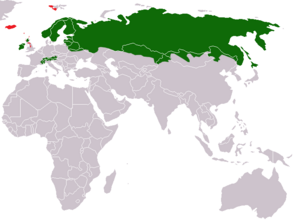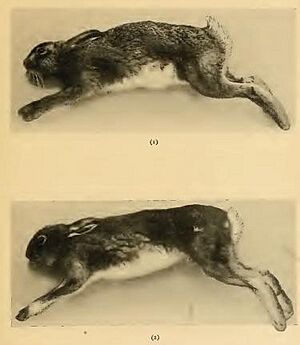Mountain hare facts for kids
Quick facts for kids Mountain hareTemporal range: Late Pleistocene to recent
|
|
|---|---|
 |
|
| In Norway | |
| Conservation status | |
| Scientific classification | |
| Genus: |
Lepus
|
| Species: |
timidus
|
 |
|
| Mountain hare range (green - native, red - introduced) | |
The mountain hare (Lepus timidus) is a type of hare that lives in cold, snowy places like mountains and the Arctic. It's also known by many other names, like blue hare, snow hare, or Irish hare. These hares are very good at living in chilly environments.
Contents
Evolution and History
Mountain hares first appeared a very long time ago, during the Late Pleistocene ice age. Scientists believe their family spread into southern Europe during these cold periods. Some other types of hares, like the Iberian hare and European hare, might even have some mountain hare ancestors.
Long ago, some mountain hares in Russia grew much bigger than today's hares. These ancient, giant hares are now thought to be an older version of the mountain hare we know.
Where They Live and Their Homes
Mountain hares live across a wide area, from Fennoscandia (like Norway and Sweden) all the way to eastern Siberia. You can also find smaller groups in the Alps, Scotland, the Baltics, northeastern Poland, and Hokkaidō in Japan.
In Ireland, a special kind of mountain hare, called the Irish hare, lives in low-lying areas. They can be found in pastures, coastal grasslands, and even salt marshes, not just in the mountains.
People have also brought mountain hares to other places. These include Iceland, Shetland, Orkney, the Isle of Man, the Peak District in England, Svalbard, and some islands in the southern ocean. In the Alps, mountain hares live high up, from about 700 to 3,800 meters (about 2,300 to 12,500 feet) above sea level. Their exact home depends on the area and the time of year.
What Mountain Hares Look Like

Mountain hares are large animals, but they are a bit smaller than the European hare. They can grow to be about 45 to 65 centimeters (18 to 26 inches) long. Their tail is short, about 4 to 8 centimeters (1.5 to 3 inches). They usually weigh between 2 and 5.3 kilograms (4.4 to 11.7 pounds). Female hares are often a little heavier than males. They can live for up to 12 years.
In summer, mountain hares have brown fur. But when winter comes, most of them change their coat to white. This helps them hide in the snow. Their tail stays white all year, which helps tell them apart from the European hare, which has a black stripe on its tail.
The Irish mountain hare (a subspecies) is smaller and stays brown all year. Some Irish hares, especially on Rathlin Island, can even have a "golden" color. In the Faroe Islands, mountain hares turn grey in winter instead of white.
Behaviour and Diet
The food mountain hares eat changes depending on where they live. For example, in northern Scandinavia, where snow covers the ground for many months, they might eat twigs and tree bark. In places like Ireland, where there isn't much snow, they mostly eat grass.
If they have a choice, mountain hares in Scotland and Ireland prefer to eat grass. In one study in Ireland, grass made up over 90% of their diet. This was even more grass than what European rabbits living in the same area ate.
Mountain hares are prey for some larger animals. They are a favorite food for the golden eagle. Eurasian eagle-owls and red foxes also hunt them. Small hares might be hunted by Stoats.
In some parts of Finland, Norway, and Sweden, mountain hares and European hares live in the same areas. European hares are bigger and can often scare away mountain hares. However, European hares are not as good at living in very snowy places. Their feet are smaller, and their winter fur is a mix of white and brown. Mountain hares are much better suited for snowy conditions. Sometimes, these two types of hares can even have babies together.
The Arctic hare was once thought to be a type of mountain hare, but now scientists consider it a separate species. Some scientists also think the Irish hare should be its own species. Currently, there are 15 known types of mountain hares.
Mountain Hares and People
Mountain hares in the European Alps live high up in the mountains. Over the past few decades, more and more people have visited these areas for winter sports like skiing. This means more ski resorts and more people in the hares' homes.
A study in 2013 found that hares living in busy ski areas showed signs of stress. They had to use more energy to deal with the disturbance, especially when food was hard to find because of the snow. Experts suggest keeping forests where hares live free from tourist developments. They also recommend not building new ski areas in hare habitats and not making existing ones bigger.
In Scotland, there have been concerns about mountain hares being hunted. Some people hunt them for sport, and gamekeepers sometimes shoot them to control their numbers. This is because some people believe hares can spread diseases to red grouse, which are game birds. Many people don't know how much hunting happens, but investigations have shown that thousands of hares are hunted each year.
In 2016, a Scottish animal welfare group called OneKind started a campaign to protect mountain hares. They wanted people to know about the hunting and to support a ban. The campaign, called "We Care For The Mountain Hare," asked the Scottish government to make laws against hunting and culling these hares. Many people supported this idea. In May 2020, lawmakers in Scotland voted to ban the hunting of mountain hares without a license and to give them protected status. This happened after a petition by Green lawmaker Alison Johnstone received over 22,000 signatures.
In 2021, a group called the People's Trust for Endangered Species helped fund a survey of mountain hares in the UK's Peak District. They were worried about this group of hares, which was brought to the area in the 1870s. Scientists believe there are only about 2,500 hares left there. The trust thinks that climate change is a threat to these hares in the long run.



